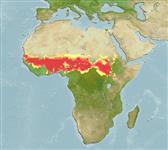Classification / Names
Common names from other countries
Main reference
Size / Weight / Age
Max length : 100.0 cm SL male/unsexed; (Ref. 31256); max. published weight: 10.2 kg (Ref. 2920)
Length at first maturity
Lm ?, range 40 - 40 cm
Environment
Freshwater; pelagic; depth range 1 - ? m (Ref. 13851)
Climate / Range
Tropical; 25°C - 30°C (Ref. 2060), preferred ?; 16°N - 3°N, 17°W - 37°E
Distribution
Africa: native in all the basins of the Sahelo-Sudanese region, the Senegal, Gambia, Corubal, Volta, Ouémé, Niger, Bénoue, Chad and Nile basins and Lake Turkana (Ref. 2920, Ref. 3012, Ref. 3514). Successful introductions in the storage reservoirs of Côte d'Ivoire, the Cross, Sanaga, Nyong and Ogowe rivers and the lower and middle Congo basin, including Ubangui and Kasaï (Ref. 2920); rapidly enlarged its distribution in the Lualaba (upper Congo basin) after extraordinary inundations in 1979 (Ref. 51906). Also introduced in Madagascar (Ref. 13333). Several countries report adverse ecological impact after introduction.
Countries | FAO areas | Ecosystems | Occurrences | Introductions
Short description
Dorsal
spines
(total): 0;
Dorsal
soft rays
(total): 32-37;
Anal
spines: 0;
Anal
soft rays: 34 - 39;
Vertebrae: 66 - 69. Elongated and robust body, its height 3.5 to 5 times in standard length (Ref. 2920). Relatively short head, its length 3.5 to 5 times in standard length (Ref. 2920, Ref. 5156). Dermal bones of the cranium are deeply carved by large sensory pits (Ref. 1878, Ref. 2920). The lips are thick and there is a dermal flap on the border of the gill cover (Ref. 13851). Conical teeth (Ref. 5156). Dorsal and anal fins, which are spineless, elongated and posteriorly positioned, ending close to the small, rounded caudal fin (Ref. 3032, Ref. 13851, Ref. 28714, Ref. 30488). Caudal peduncle very short (Ref. 2756, Ref. 3054, Ref. 3069). Strong, large scales (Ref. 28714, Ref. 30488), oval with the exposed portion thick and corrugated, with a more or less vermiform sculpture (Ref. 53264): 34-40 lateral-line scales, 2.5/6 scales on the lateral side of the body before the pelvic fin, 5-6 scales between dorsal and anal fin (Ref. 367, Ref. 2756, Ref. 2920, Ref. 5156). The lateral line is extending in a straight line from above the operculum to the middle of the caudal peduncle (Ref. 1878). The number of gill rakers increases with the length; 33 (young) to 98 on the ceratobranchial and 21 (young) to 76 on the epibranchial (Ref. 2920). Young specimens possess external gills (Ref. 30488). Uniform gray, brown or bronze colored (Ref. 2920), darker during the reproduction-period (Ref. 367). Young specimens are often marked with dark longitudinal bands and scales with an oval spot in the posterior zone of the anal and dorsal fin (Ref. 2920).
IUCN Red List Status (Ref. 115185)
Threat to humans
Potential pest (Ref. 40814)
Human uses
Fisheries: commercial; aquaculture: commercial; aquarium: commercial
More information
ReferencesAquacultureAquaculture profileStrainsGeneticsAllele frequenciesHeritabilityDiseasesProcessingMass conversion
Tools
Special reports
Download XML
Internet sources
Estimates of some properties based on models
Phylogenetic diversity index
PD50 = 1.0312 many relatives (e.g. carps) 0.5 - 2.0 few relatives (e.g. lungfishes)
Trophic Level
2.7 ±0.1 se; Based on diet studies.
Resilience
Medium, minimum population doubling time 1.4 - 4.4 years (K=0.22-0.4; Fec > 1,000)
Vulnerability
Moderate to high vulnerability (55 of 100)
Price category
